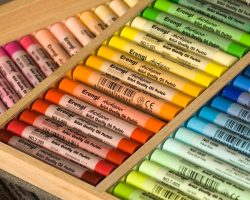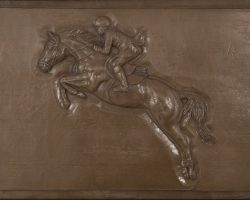
My favorite oil pastel sets from cheap to expensive
How to choose your oil pastel set for sketching and serious art work
Oil pastels are one of my favorite painting and drawing medium. Based on my personal experience I want give answers to the question: What is the best oil pastel set to buy or to start with? It depends on the purpose you want to use it for. If you are looking for a set to be given to children you might want to look for a water soluble and more harder oil pastel or wax crayon. Illustrators who mostly do not exhibit their work but store it after scan in a drawer away from light can use a cheaper quality if they prefer a certain brand or set at lower price.
For more ambitious wor the set shown on the image is a portrait set of oil pastels by Sennelier available on amazon.com might be better. It contains those colours best suitable for portrait work i.e. for skin and hair colours. Sennelier is a producer of highest quality oil pastels. Work created with their oil pastels is suitable for long term exposure under normal room daylight, which still contains some of the UV-light that causes colours with less and cheaper pigment load to fade over time.
A fairly good guideline for quality is the price of oil pastels. The competition in this field is very strong especially in the low segment. Therefore you can be sure that a more expensive quality will be the better quality: the sticks last longer, more vibrant colours and better light fastness along with some better properties in handling.
The second reliable criterion is the brand name. Choosing from long established renowned brands will make sure that you get a good quality. That does not say that an unknown brand is not good enough. I try unknown brands on a regular basis if they have colours that seem interesting to me and make a good addition to my sets.
What are the best oil pastels brands
best quality oil pastel brands ,some choices
Of course each artist has his/her own preferences. But when you investigate which brands are used by professional artists or have been used on really stunning art work you most probably will find the same brand names again and again. I do not want to put these brands in a ranking order, it is more about being on that list or not: Sennelier, Holbein, Caran d’Ache, GretaColor for highest qualities and Pentel, Sakura and van Gogh for more price worthy qualities. Most of these brands or companies are known for great colours also in other fields like oil painting or coloured pencil.
The expensive artist oil pastels typically cost around 1-2 $ per small stick, the less expensive ones are very well below 1$ per stick.
Holbein offers an expensive artist oil pastel grade and a less expensive studio quality. Sennelier is famous for their very creamy and pigment rich oil pastels in small and big stick, whereas Caran d’ Ache has developed a range of different grades between soft artist grade named “Neopastel” and less expensive and harder , even water soluble brands named “Neocolor”.
It is possible to use different qualities in the same work, for example a layer of harder pastels as under painting and softer qualities on top.
I have used Caran d’Ache Neocolor for the oil pastel study painting after John Constable’s sketch Dedham lock & mill
Which colours are critical in oil pastel sets ?
Critical colours are those colours that you use more often and in larger quantities than others! The second category of critical colours are those which tend to fade faster than others due to their nature.
1. Colors that you use regularly and which you need in larger quantities
What you need to know before you buy a set is whether colours that are used up can be replaced easily. Is it possible to get that greens you need in spring easily via online order or at your art dealer not to far away? That could limit your choice already quite a bit. Imagine you started a piece and you run out of a certain colour hue. If you need to continue with a different brand your work might not look as good as you wish. I usually need more often natural greens,ochre,all grays and browns, blues and white which are the main colours for landscape work.
2. Which colours are critical due to pigment.
What I have learned from my teachers is that certain colours in pastels as in other colors tend to fade quicker than others due to the nature of the available pigment for those colours. It is commended to use the best quality of colors if possible for work that contain delicate red and pink colour hues. The same applies for orange hues. Therefore artists who specialize on flower still life will pay particular attention to the light fastness of their oil pastels.
The Caran d’Ache oil pastel sets
48 and 96 color sets
Caran d’ Ache 48 color setThese are the sets that I own. The first one is the smaller 48 color set. The colors are ordered in 12 groups of four colors each. This order is very helpful to develop an intuitive understanding of colors and hues, their relations ships and mixing potential. As Plein air painter I appreciated the many shades of green in this selection.
Caran d’ Ache 96 color setThe 96 color set expands the range considerably. There are even two metallic colors, bronze and gold, which are nice to have for special purposes. The consists of two boxes which are stored on top of each other. Cpmpared to the 48 color set the range of greys is large. Also there are very nice hues of “beige”, which I consider warm greys I really appreciate for outdoor painting. In addition to that the range of browns and blues are much bigger.

